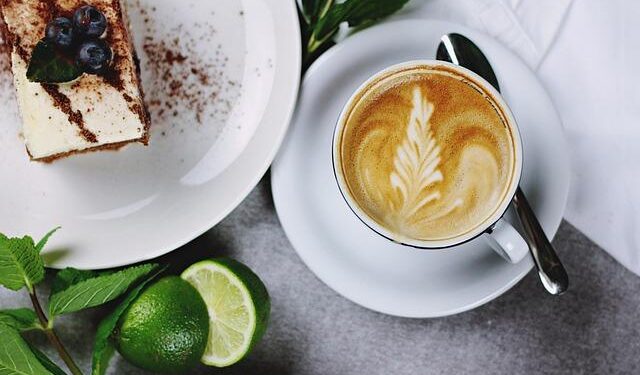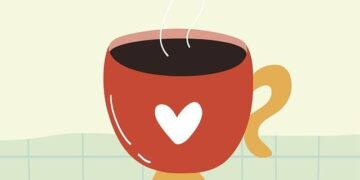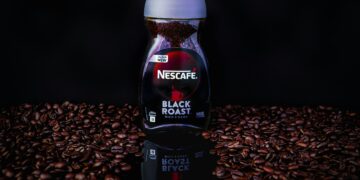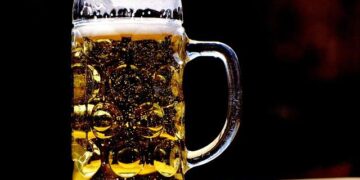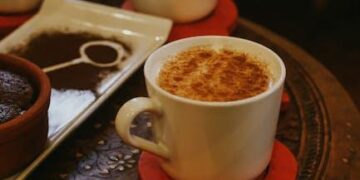Table of Contents
For as long as I can remember, I’ve been on a quest for the perfect glass of iced tea.
It sounds simple, but as anyone who has pursued this seemingly modest goal knows, it’s a journey fraught with peril.
I’m a food scientist now, with more than a decade of experience deconstructing flavors and textures in a lab, but my obsession started much earlier, born from pure, unadulterated frustration.
For me, iced tea has always existed at two disappointing extremes.
First, there was the Hot-Brewed Hazard.
This is the method most of us grew up with: boil water, toss in a few tea bags, and hope for the best.
The problem is, life happens.
A phone call, a distraction, and suddenly that five-minute steep turns into fifteen.
The result? A pitcher of beautiful amber liquid that tastes like a bitter, tannic punishment.
That puckering, mouth-drying sensation is the taste of failure—the aggressive over-extraction of compounds that should have been left in the leaf.
On the other end of the spectrum was the Cold-Brew Conundrum.
I discovered early on that steeping tea in cold water for a long time produced a miraculously smooth, sweet, and forgiving brew.
It was a revelation.
But it came with a steep price: time.
The standard advice was to let it sit in the fridge for 12, sometimes even 24 hours.
Perfect iced tea was achievable, but it required the kind of planning I rarely possessed.
My most formative failure, the one that arguably set me on my professional path, involved a large glass jar and a sunny porch.
It was the quintessential image of summer: “sun tea.” I combined water and tea bags, set it out to bask in the afternoon heat, and imagined the glorious, perfectly brewed tea I’d have by evening.
What I got instead was a cloudy, strangely bitter concoction that tasted… off.
It wasn’t just a culinary flop; it was a scientific puzzle.
I would later learn in my food science courses that sun tea is a terrible idea, creating a lukewarm breeding ground for bacteria that boiling water would have killed and a cold fridge would have inhibited.
It was both unpalatable and unsafe.
This history of frustration is why, years later, standing in a supermarket aisle, I felt a profound sense of skepticism.
There, on the shelf, was a box of Lipton “Cold Brew” tea bags promising a perfect pitcher of iced tea in just five minutes.
Five minutes.
In cold water.
My inner scientist scoffed.
It seemed to defy the laws of extraction I had come to understand so intimately.
How could it possibly replicate a 12-hour process in 1/144th of the time? Was this a genuine leap in food science, a revolutionary product that solved the eternal iced tea dilemma? Or was it just a clever marketing deception, preying on the hopes of thirsty, impatient people like me? I bought a box.
The investigation had begun.
Part I: The Science of a Steep — Understanding the Soul of Tea Extraction
To solve the mystery of the 5-minute cold brew, I first had to go back to the fundamentals.
The difference between a sublime cup of tea and a bitter drain-pour isn’t magic; it’s chemistry.
It all comes down to how flavor and other compounds are extracted from the tea leaf, a process governed by temperature, time, and the very nature of water itself.
The Wrecking Ball of Heat
Think of hot water as a demolition crew with a wrecking ball.
When you pour boiling water over tea leaves, you are unleashing highly energized water molecules.
These molecules move with speed and violence, crashing into the cellular structure of the tea leaf and forcibly ejecting everything inside—the good, the bad, and the bitter.
This aggressive extraction is why hot brewing is so fast.
But it’s also why it’s so risky.
The most desirable compounds—delicate floral and fruity notes—are released quickly.
But so are the larger, more cumbersome molecules that we often want to keep in check.
The primary culprits here are tannins, a class of polyphenols that create astringency (that dry, puckering feeling on your tongue) and bitterness.
Caffeine, another bitter compound, is also highly soluble in hot water and is extracted in large amounts.
If you steep for too long, these less-desirable compounds overwhelm the delicate ones.
You’ve swung the wrecking ball too long, and now you’re left with rubble.
Interestingly, this aggressive approach isn’t all bad.
For certain teas, like black tea, a short, hot brew can be the most effective way to extract the maximum amount of beneficial antioxidants, specifically certain types of catechins.
The trade-off is that you are dancing on a razor’s edge between health benefits and a flavor catastrophe.
The Archaeological Dig of Cold
If hot brewing is a wrecking ball, traditional cold brewing is a patient archaeological excavation.
The water molecules in cold water are slow, calm, and gentle.
They don’t smash into the tea leaf; they carefully and methodically brush away the most accessible, highly soluble compounds over a long period.
This gentle persuasion fundamentally changes the chemical composition of the final brew.
The first molecules to dissolve and float away are the smaller, lighter ones:
- Amino Acids: These are responsible for the savory, brothy, or “umami” notes in tea, particularly prominent in high-quality green teas. They contribute to a richer mouthfeel.
- Simple Carbohydrates: These provide a natural, inherent sweetness to the brew, a quality often masked by the bitterness of a hot brew.
Because the extraction is so slow and gentle, the larger, more stubborn molecules—the bitter tannins and a significant portion of the caffeine—are largely left behind, still locked within the leaf.
They are simply less soluble in cold water.
The result is a tea that is chemically different: smoother, naturally sweeter, less astringent, and with about half to two-thirds the caffeine of its hot-brewed counterpart.
This entire dance of molecules is governed by a fundamental physical process: osmosis.
Osmosis is the movement of a solvent (in this case, water) across a semi-permeable membrane (the cell walls of the tea leaf) from an area of lower solute concentration to an area of higher solute concentration.
In simpler terms, the water is trying to dilute the concentrated “tea stuff” inside the leaf.
You can see this principle in your own kitchen: if you place a carrot stick in very salty water, the water inside the carrot will be drawn out to try and dilute the salt, leaving the carrot limp and dehydrated.
In tea, osmosis is the engine that pulls flavor from the leaf into your pitcher.
Heat supercharges this engine; cold lets it run at a slow, steady pace.
Understanding this science reveals that the choice of brewing method isn’t a simple binary of “good” vs. “bad.” It’s a negotiation of trade-offs, what I call the Brewer’s Trilemma.
You are constantly balancing three variables:
- Time: How quickly do you need your tea?
- Flavor Profile: Do you want a smooth, sweet brew or a bold, brisk one?
- Bio-actives: Are you trying to maximize antioxidants or minimize caffeine?
A traditional hot brew prioritizes speed and, potentially, certain antioxidants, but at the risk of a bitter flavor.
A traditional cold brew prioritizes a smooth flavor and lower caffeine, but at the cost of significant time.
It seemed impossible to have it all.
And yet, the box of 5-minute “cold brew” bags on my counter claimed to have solved the trilemma.
My investigation deepened.
Part II: The Investigation — Cracking the 5-Minute Cold Brew Code
With the scientific principles established, I turned my attention to the product itself.
My kitchen counter became a lab, the tea box my subject.
To solve the mystery, I needed to go beyond the marketing claims and look for concrete evidence, treating it like a forensic case.
The Plot Thickens – Conflicting Clues from the Field
My first step was to survey the existing intelligence.
I dove into online tea forums and communities, the digital town squares where enthusiasts trade wisdom and debate minutiae.
The opinions on “fast-brew” tea bags were sharply divided, creating a confusing cloud of conflicting clues.
In one camp were the skeptics, who dismissed the product as a pure marketing gimmick.
“Same tea, zero difference in the actual tea,” one user confidently stated.
Another echoed, “It’s marketing.
There’s likely no difference between standard tea bags and tea bags labeled as ‘cold brew'”.
This theory suggested that companies were simply rebranding their existing product to cash in on the cold brew trend.
But in the other camp were industry insiders and observant users who insisted there was a tangible difference.
One person, claiming to have worked in the tea industry for years, offered a compelling counter-argument: “It’s not the same.
Cold brew teas have a concentrated formula…
A regular tea will take 12-24 hours in cold water to release the same amount of flavour as a cold brew bag.
Also, if you steep a cold brew bag in hot water it is revoltingly strong”.
Others pointed to more specific physical differences, noting that the tea was often ground into a fine dust or that the bags contained additives like crystallized fruit juice to boost flavor.
The evidence was contradictory.
Was it a placebo effect, or was there a real technological difference at play? I needed to look closer.
Under the Microscope – Deconstructing the “Fast-Brew” Bag
Putting on my food scientist hat, I began to analyze the product based on the clues.
If a company wanted to engineer a tea bag that infuses rapidly in cold water, there are a few key levers they could pull.
The evidence pointed to three main strategies.
Clue #1: The Dust Particle Theory. The first and most obvious modification relates to surface area.
A standard tea bag contains broken, but still recognizable, leaf pieces.
Many of the “fast-brew” bags, upon inspection, contain something closer to a fine powder or “fannings”.
This isn’t necessarily a sign of lower quality in this context; it’s a deliberate engineering choice.
By pulverizing the tea leaves, you dramatically increase the total surface area that is exposed to the water.
This provides countless more points of contact for osmosis to occur, radically accelerating the extraction process.
More surface area equals a much faster infusion.
Clue #2: The Solubility Solution. The second clue was right on the ingredient list of many flavored versions.
While a standard tea bag might list only “Black Tea,” a box of Twinings Peach Cold Brew lists “Black tea, Natural peach and tea flavour with other natural flavours, Black and green tea extracts”.
A Celestial Seasonings Sweetened Tea with Lemon includes “True Lemon (citric acid…),” “Honey Granules,” and “Stevia Extract”.
These aren’t just for taste.
Ingredients like tea extracts, citric acid, and powdered flavorings are chosen for their high solubility in cold water.
They dissolve almost instantly, providing a rapid payload of flavor and aroma that the tea leaves, even when pulverized, couldn’t deliver on their own in just five minutes.
They give the brew a significant head start.
Clue #3: The Safety Protocol. Finally, I considered the lesson from my sun tea disaster.
Any food product designed to be prepared without a “kill step”—like boiling water—needs to be safe.
An experienced tea formulator on a forum confirmed my suspicion: for cold brew products, there’s often an added germ-reduction step during processing to mitigate the risk of bacterial growth, a step unnecessary for tea destined for a kettle.
This behind-the-scenes safety protocol is another key difference in the manufacturing process.
The Epiphany – It’s Not Cold Brew, It’s Sous-Vide Tea
The clues were adding up.
Increased surface area, added soluble ingredients, and a different safety protocol.
This was clearly a different product.
But the big picture, the unifying theory, still eluded me.
It felt like a clever hack, but I couldn’t quite articulate what it was a hack of.
The breakthrough, the “aha!” moment, came from a completely different corner of the culinary world: modernist cuisine and the technique of sous-vide.
For years, coffee enthusiasts have been experimenting with what they call “sous-vide cold brew”.
The problem they face is the same as with tea: true cold brew coffee is smooth and low in acid but takes 12-24 hours to make.
The sous-vide solution is a thermal shortcut.
They seal coffee grounds and water in a jar or bag and place it in a water bath heated to a precise, low temperature—typically around 150°F (65°C), well below boiling.
At this gentle, controlled temperature, they can achieve a flavor profile that mimics true cold brew—low bitterness, low acidity—in as little as two hours.
It’s not technically cold, but it achieves the same desired result by carefully manipulating the extraction chemistry.
And that was it.
The epiphany hit me with the force of a perfectly brewed espresso.
The 5-minute “cold brew” tea bag is the chemical and physical equivalent of the sous-vide method.
It’s a different kind of shortcut to the exact same goal.
Where sous-vide uses low, controlled heat to accelerate extraction, the fast-brew tea bag uses massively increased surface area (dust) and highly soluble additives (extracts) to achieve the same end.
This insight resolved the central mystery.
The product wasn’t a “deception” or “fake” cold brew.
It was a different category of beverage technology altogether.
It’s an engineered solution designed to replicate the result of cold brew (a smooth, non-bitter flavor) without replicating the process (a long, slow, gentle steep).
The name “Cold Brew” is a brilliant piece of marketing because it communicates the intended flavor profile to the consumer, even if the science behind it is completely different.
My skepticism melted away, replaced by a scientist’s admiration for a clever piece of food engineering.
Part III: The Expert’s Playbook for Perfect Iced Tea
With the mystery solved, my frustration was replaced by a sense of empowerment.
I now understood the tools at my disposal.
The “fast-brew” bag and the “slow-brew” method weren’t competitors; they were two different instruments for two different occasions.
The final step of my journey was to translate this scientific understanding into a practical playbook that anyone could use to achieve their own version of iced tea nirvana.
From Skeptic to Strategist – How to Read the Box and Buy with Confidence
The key to buying the right product is knowing what to look for.
The ingredient list is your Rosetta Stone.
- Decoding the Label: When you pick up a box, look past the front-of-pack claims. If the ingredient list simply says “Black Tea” or “Green Tea,” you are holding a standard tea bag, best suited for hot brewing or a traditional, long cold brew. If you see ingredients like “tea extract,” “citric acid,” “natural flavors,” or sweeteners like “stevia extract,” you are holding a fast-brew product engineered for speed in cold water. Citric acid, for example, is a double-agent: it adds a bright, tart flavor note and also helps with solubility.
This distinction allows you to define the job for each product:
- “Fast-Brew” Bags: Use these when your priority is convenience, speed, and consistency. They are perfect for a last-minute pitcher for guests, a quick glass on a busy weekday, or when you want a specific, pre-formulated flavored tea.
- “True” Cold Brew (using regular bags or loose leaf): Use this method when your priority is flavor purity, ritual, and control. This is for the tea purist who wants to taste the unadulterated character of a specific tea leaf, who enjoys the slow process, and who wants complete control over every ingredient in their pitcher.
The Ultimate Cold Brew Tea Bag Showdown
To make the choice even clearer, I’ve compiled a comparative analysis of popular “fast-brew” products on the market.
This table synthesizes the information scattered across websites and packaging into a single, actionable resource.
| Brand & Product | Stated Brew Time | Key Formulation Clues | Flavor Profile & Notes | Best Use Case |
| Lipton Cold Brew Black Tea | 5 minutes | “Black Tea” (Argentina). Likely uses fine grind for speed. | Crisp, smooth, classic black tea flavor. Milder than hot-brewed Lipton. | Excellent, affordable, and reliable base for a large pitcher of unsweetened iced tea. |
| Twinings Peach Cold Brewed | 3-5 minutes | “Black tea, Natural peach and tea flavour…, Black and green tea extracts” | Juicy, forward peach flavor balanced with black tea. A distinct, orchard-fresh aroma. | A quick, refreshing, and satisfying flavored iced tea for those who enjoy fruity blends. |
| Twinings Green and Mint Cold Brewed | 5 minutes | “Green tea, Peppermint leaves, Natural mint flavour…, Black and green tea extracts, Citric acid” | Light and refreshing green tea base with a clear, fragrant peppermint note. | A sophisticated, lighter alternative to black iced tea, perfect for an afternoon pick-me-up. |
| Celestial Seasonings Red, White & Blueberry | 5 minutes | “Red and White Hibiscus, Natural Raspberry and Blueberry Flavors…, Blueberries” | Caffeine-free. Bright, tart, and dominated by hibiscus with notes of berry. | A vibrant, flavorful, and caffeine-free herbal option. Excellent for parties and kid-friendly. |
| Celestial Seasonings Sweetened Tea with Lemon | 5 minutes | “Black Tea and Tea Extract, True Lemon (citric acid…), Honey Granules…, Stevia Extract” | A complete “Arnold Palmer” style drink. Sweetened with honey and stevia, with a strong lemon flavor. | An all-in-one solution for those who want a sweetened, lemon-flavored iced tea without any mixing. |
The Cold Brew Troubleshooting Guide: A Scientist’s Solutions
Even with the right product, things can go wrong.
But when you understand the underlying science, troubleshooting becomes simple.
- Problem: My tea is weak and watery.
- Scientific Cause: An incorrect tea-to-water ratio or insufficient extraction.
- Solution: For a true cold brew with regular bags or loose leaf, you need more tea than you think. The gentle extraction requires a higher concentration of leaves to achieve a robust flavor. A good starting point is to use 1.5 to 2 times the amount of tea you would for a hot brew. For fast-brew bags, the issue is likely too much water. Stick to the brand’s recommended volume (e.g., “2 tea bags per 8 cups water”) for the intended strength. Also, remember that loose-leaf tea, with its smaller surface area, will always extract more slowly than the fine dust in a purpose-built bag.
- Problem: My flavored tea tastes imbalanced (e.g., all cinnamon, no tea).
- Scientific Cause: Different flavor compounds have different solubility rates in cold water.
- Solution: This is a classic chemistry problem. Some flavor molecules, like the cinnamaldehyde in cinnamon, are highly soluble even in cold water, while the core compounds of the tea leaf are less so. The cinnamon flavor is simply extracting much faster than the tea flavor. For these specific blends, you have two options: 1) Brew it hot and then chill it to achieve a more balanced extraction, or 2) Dilute the blend by adding a plain, unflavored black tea bag to your pitcher to adjust the ratio of tea-to-flavoring.
- Problem: My tea looks pale and dull.
- Scientific Cause: The compounds responsible for color do not extract at the same rate as the compounds responsible for flavor.
- Solution: Don’t judge a brew by its color! A pale appearance, especially with green or white teas, is common in cold brew and is not an indicator of weak flavor. Trust your palate. The tea can be incredibly fragrant and smooth even if it’s light in color. If you absolutely must have a darker color for aesthetic reasons, you can add a splash of strongly brewed (and chilled) hot tea as a natural colorant.
- Problem: I’m worried about safety.
- Scientific Cause: Bacterial proliferation in a lukewarm, non-sterile environment.
- Solution: This is the most critical point. Never make sun tea. The practice is a recipe for foodborne illness. Always brew your tea in the refrigerator, where the cold temperature inhibits bacterial growth. Start with a scrupulously clean pitcher or jar. If you are using loose-leaf tea and remain concerned, you can give the leaves a very quick rinse with hot (not boiling) water before starting your cold brew to provide extra peace of mind.
The Purist’s Corner – A Masterclass in True Cold Brew
For those moments when you have time and want to connect with the pure essence of the tea leaf, here is the definitive method for a traditional, slow cold brew.
- Select Your Tea: This method is where high-quality tea truly shines. Delicate green teas (like Sencha or Dragonwell), white teas, and many oolongs are spectacular, as the gentle process highlights their nuanced, sweet, and floral notes without any risk of bitterness. Fruit-infused herbal blends also work beautifully. Black teas can be used, but they may require a shorter steeping time (e.g., 8-10 hours) to avoid developing any bitterness, even in the cold.
- Find Your Ratio: The golden rule is to use more leaf than you would for hot tea. Start with a ratio of 1 to 2 teaspoons of loose-leaf tea (or one standard tea bag) for every 8 ounces (1 cup) of water. You can adjust this up or down over time to match your personal preference for strength.
- Use Good Water: Your tea is over 99% water, so the quality matters. Using filtered water will prevent any off-flavors from your tap from interfering with the delicate taste of the tea.
- Steep with Patience: Combine your tea and cold, filtered water in a clean glass jar or pitcher. Give it one gentle stir or shake—some studies suggest this initial agitation may help release more antioxidants. Seal the container and place it in the refrigerator. Steeping times vary by tea type:
- Green & White Teas: 4 to 6 hours.
- Oolong & Black Teas: 8 to 12 hours.
- Herbal Infusions: 12 hours or more.
- Strain and Store: Once the steeping is complete, strain the tea leaves out using a fine-mesh sieve or by simply removing the tea bags. Store your finished cold brew in a sealed container in the refrigerator. It is best enjoyed within 3 to 4 days for optimal freshness.
Conclusion: Two Paths to Iced Tea Nirvana
My journey, which began with a bitter glass of sun tea and a skeptical glance in a supermarket aisle, has come full circle.
The frustration is gone, replaced by the clarity that only comes from deep investigation.
The “cold brew deception” was never a deception at all; it was my own misunderstanding of the technology.
I was trying to judge a clever piece of food engineering by the standards of an artisanal craft.
I now see that they are not rivals, but two different, equally valid tools designed for the same noble purpose: a perfect glass of iced tea.
Just last week, this new understanding was put to the test.
Unexpected guests were due to arrive in thirty minutes on a sweltering afternoon.
In my pre-epiphany days, I would have panicked, knowing I had no pre-made iced tea and no time for a proper cold brew.
Instead, I calmly walked to my pantry, pulled out a box of 5-minute “fast-brew” tea, and filled a pitcher with cold water.
Five minutes later, as my guests walked through the door, I was pouring glasses of perfectly clear, smooth, refreshing iced tea over i.e. I was no longer a victim of my iced tea cravings, but a master of my craft.
Ultimately, the choice between a 5-minute bag and a 12-hour steep is not about which is “better,” but about which is better for you, right now.
Armed with the science of extraction and an understanding of the technology, you are now empowered.
You can navigate the tea aisle with the confidence of a food scientist, choosing the right method for any occasion.
You can troubleshoot any problem that arises.
You can finally end your own quest and achieve that perfect, sublime glass of iced tea, whenever and however you want it.
That is the taste of true iced tea nirvana.
